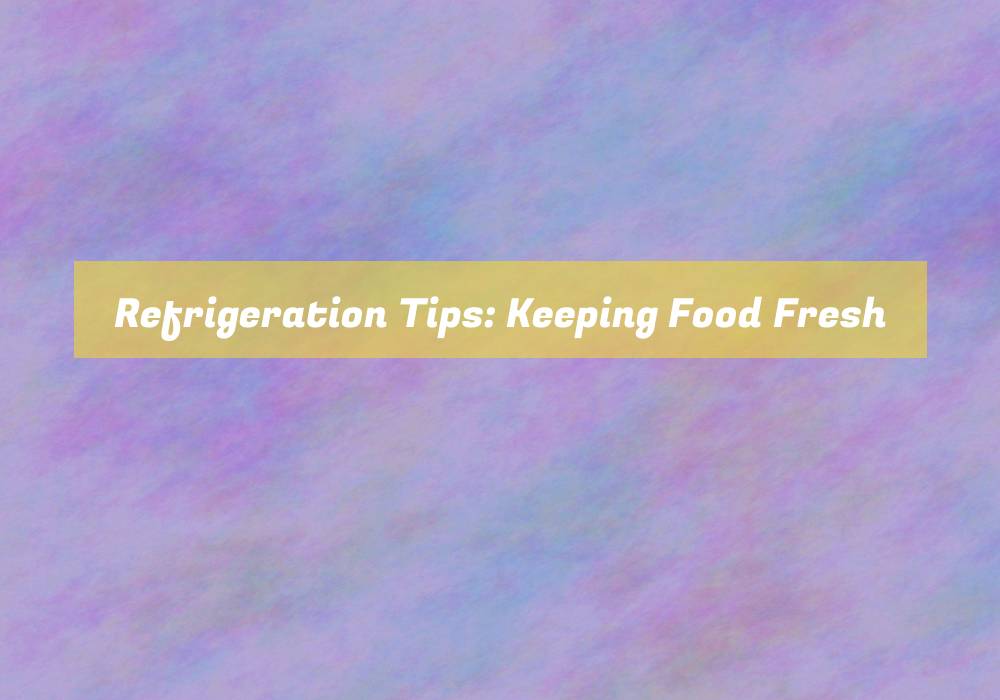Refrigeration Tips: Keeping Food Fresh
When it comes to keeping your food fresh, proper refrigeration is key. You may already be familiar with some basic tips for storing food in the fridge, but there are often overlooked details that can make a significant difference in the longevity and quality of your groceries.
From understanding the optimal storage temperatures for different types of food to efficiently organizing your refrigerator to make the most of its space, these simple yet effective strategies can help you minimize food waste and ensure that your meals stay fresh and delicious.
Proper Storage Temperatures
To keep your food fresh, itG??s crucial to store it at the appropriate temperatures to prevent spoilage and maintain quality. For perishable items such as meat, poultry, and seafood, the refrigerator temperature should be set at 40-?F (4-?C) or below. ItG??s important to use a refrigerator thermometer to ensure that the temperature stays within this range. Additionally, the freezer temperature should be at 0-?F (-18-?C) to keep frozen foods safe for consumption. When storing dairy products like milk and yogurt, maintaining a consistent temperature of 40-?F (4-?C) is essential to prevent bacterial growth.
On the other hand, certain fruits and vegetables shouldnG??t be stored in the refrigerator. Items like tomatoes, potatoes, onions, and garlic are best kept in a cool, dry place away from direct sunlight. Storing them in the refrigerator can affect their texture and taste. However, leafy greens, berries, and herbs should be refrigerated to maintain their freshness.
Organizing Your Refrigerator
When organizing your refrigerator, ensure that the temperature settings align with the storage needs of different food items, maintaining freshness and preventing spoilage.
Start by designating specific areas for different food categories. Keep dairy products, like milk and cheese, on the middle shelves where the temperature is most consistent.
Store raw meat, poultry, and seafood on the bottom shelf to prevent any potential drips from contaminating other foods.
Utilize the humidity-controlled drawers for fruits and vegetables, adjusting the settings based on the produce to maintain optimal freshness.
Consider using clear storage containers to group similar items together, making it easier to locate and use them.
Additionally, label and date leftovers and pre-prepared meals to ensure theyG??re consumed before expiration.
Maximize door storage for items with natural preservatives like condiments, jams, and juices as the temperature fluctuates more in this area.
Regularly check for expired or spoiled items, discarding them promptly to free up space and maintain a clean environment.
Maximizing Shelf Life
Consider storing perishable items like meat and dairy products in the coldest part of your refrigerator to extend their shelf life. The colder temperature helps slow down the growth of bacteria, keeping your food fresher for longer. Additionally, make sure to keep your refrigerator at the optimal temperature, which is 35-38-?F (1.6-3.3-?C), as this helps maintain the freshness of your perishable items.
When it comes to fruits and vegetables, proper ventilation is key to maximizing their shelf life. Store them in the designated crisper drawers, and make sure to keep them separate, as some fruits release ethylene gas, which can cause vegetables to spoil faster. Furthermore, consider using airtight containers or resealable bags to store leftovers and other prepared foods. This helps prevent exposure to air, which can cause food to spoil more quickly.
Regularly check the expiration dates of your food items and consume them before they go bad. This simple habit can help you avoid food waste and ensure that youG??re consuming your food at its freshest.
Storing Leftovers
For optimal storage of leftovers, use airtight containers to maintain freshness and prevent exposure to air, which can cause food to spoil more quickly.
When storing leftovers, itG??s crucial to ensure that the containers are airtight to keep the food from deteriorating.
Leftovers should be stored in shallow containers to allow for even cooling and to prevent the growth of bacteria.
ItG??s important to refrigerate leftovers promptly, ideally within two hours of cooking, to prevent the growth of harmful bacteria.
When transferring hot food to storage containers, allow it to cool slightly before sealing the container and placing it in the refrigerator.
Additionally, label the containers with the date the food was prepared to track its shelf life and ensure itG??s consumed before it goes bad.
Always store leftovers in the refrigerator rather than on the countertop, as temperatures above 40-?F can encourage bacterial growth.
Conclusion
So, by following these simple refrigeration tips, you can ensure that your food stays fresh for longer periods of time.
Remember to set the proper storage temperatures, organize your refrigerator effectively, maximize shelf life by using airtight containers, and store leftovers properly.
By putting these tips into practice, you can reduce food waste and save money in the long run.
Happy refrigerating!






Ah, the refrigerator: that magical portal where leftovers go to live out their days and where vegetables negotiate their own shelf time to avoid an untimely fate in the compost bin. I must admit, I was blissfully unaware of the art and science of refrigeration until my friend, the self-proclaimed food safety guru, dropped some knowledge that absolutely blew my mind.